Detailed System Analysis of My Healthcare Application Project
VerifiedAdded on 2021/04/21
|11
|1914
|294
Project
AI Summary
This project presents a comprehensive system analysis of a healthcare application, encompassing various aspects of its design and functionality. It begins with a stakeholder map, identifying key internal and external stakeholders such as project managers, sponsors, patients, and medical officers, along with their respective interests. A questionnaire designed for specialists explores the application's suitability for video conferencing, remote treatment suggestions, and collaborative platforms. The core of the analysis is the use case diagram and detailed descriptions, illustrating functionalities like registration, chat, updating patient treatment records, video conferencing, user deletion, patch installation, and registration approval. Each use case is thoroughly explained, detailing the actors, system stakeholders, preconditions, post-conditions, and the flow of activities. The project concludes with a 'Login' use case scenario and a comprehensive bibliography, referencing relevant literature on healthcare applications, wireless sensor networks, UML diagrams, and stakeholder management. This analysis provides a detailed understanding of the application's architecture, user interactions, and system processes, crucial for its effective implementation and improvement.
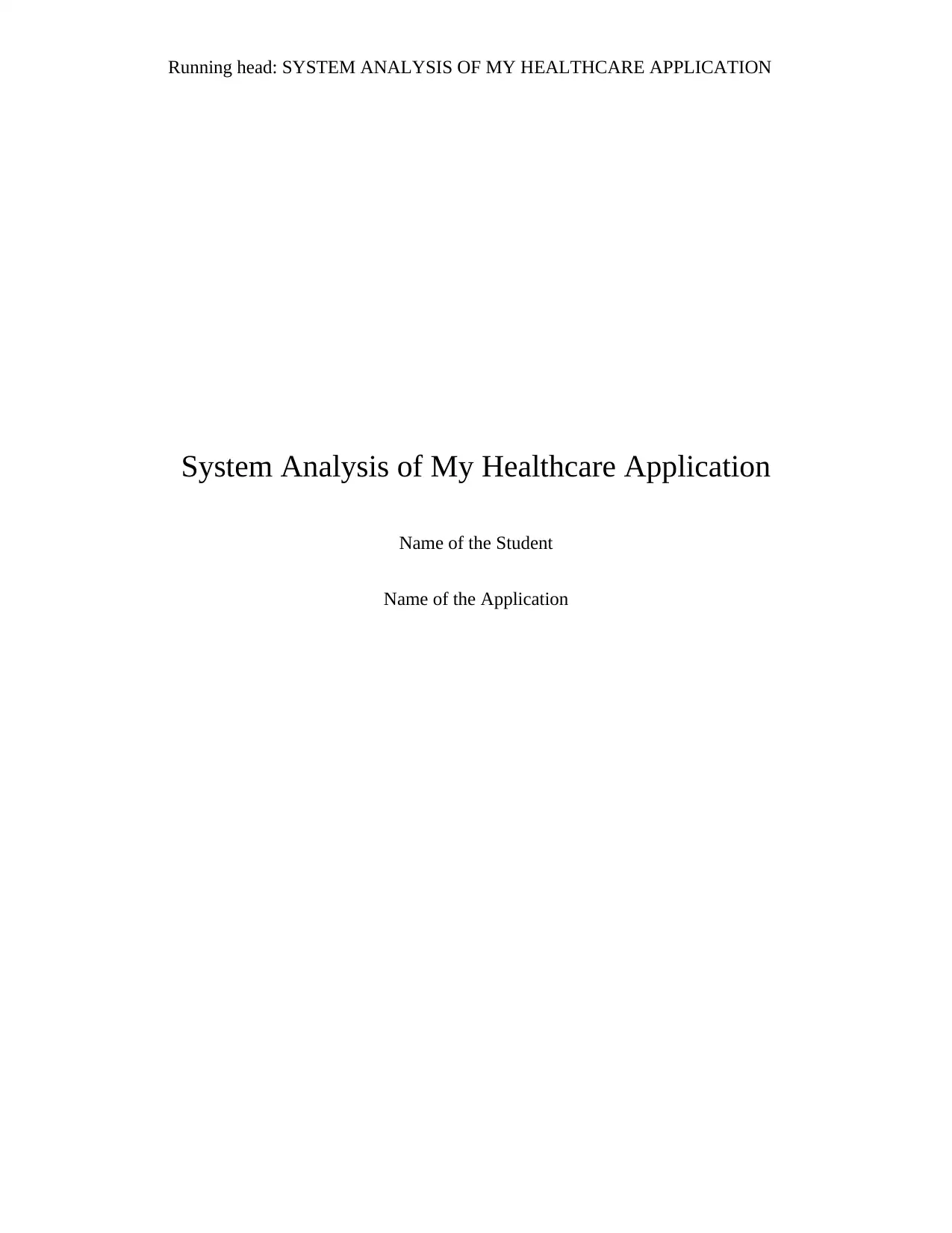
Running head: SYSTEM ANALYSIS OF MY HEALTHCARE APPLICATION
System Analysis of My Healthcare Application
Name of the Student
Name of the Application
System Analysis of My Healthcare Application
Name of the Student
Name of the Application
Paraphrase This Document
Need a fresh take? Get an instant paraphrase of this document with our AI Paraphraser
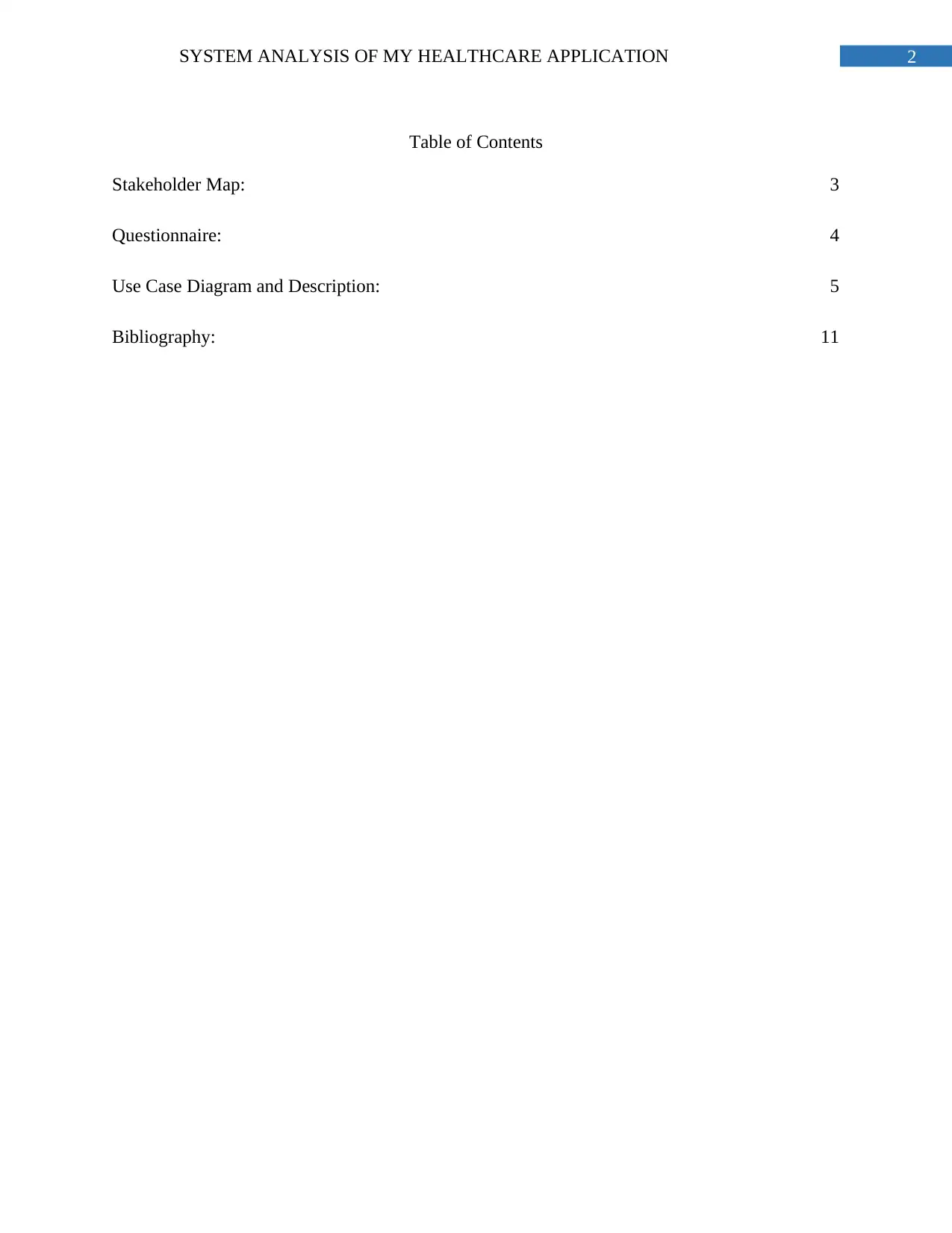
2SYSTEM ANALYSIS OF MY HEALTHCARE APPLICATION
Table of Contents
Stakeholder Map: 3
Questionnaire: 4
Use Case Diagram and Description: 5
Bibliography: 11
Table of Contents
Stakeholder Map: 3
Questionnaire: 4
Use Case Diagram and Description: 5
Bibliography: 11
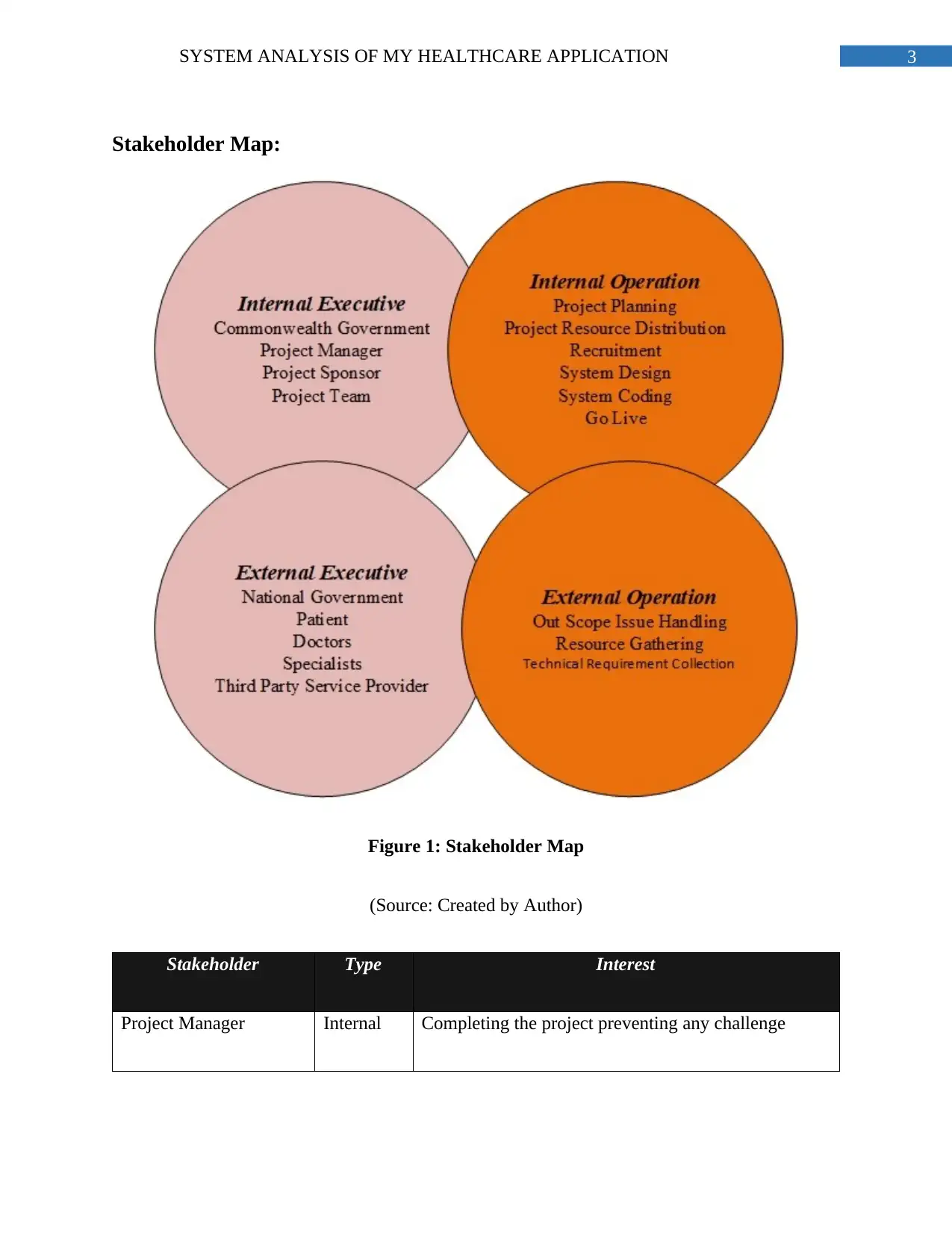
3SYSTEM ANALYSIS OF MY HEALTHCARE APPLICATION
Stakeholder Map:
Figure 1: Stakeholder Map
(Source: Created by Author)
Stakeholder Type Interest
Project Manager Internal Completing the project preventing any challenge
Stakeholder Map:
Figure 1: Stakeholder Map
(Source: Created by Author)
Stakeholder Type Interest
Project Manager Internal Completing the project preventing any challenge
⊘ This is a preview!⊘
Do you want full access?
Subscribe today to unlock all pages.

Trusted by 1+ million students worldwide
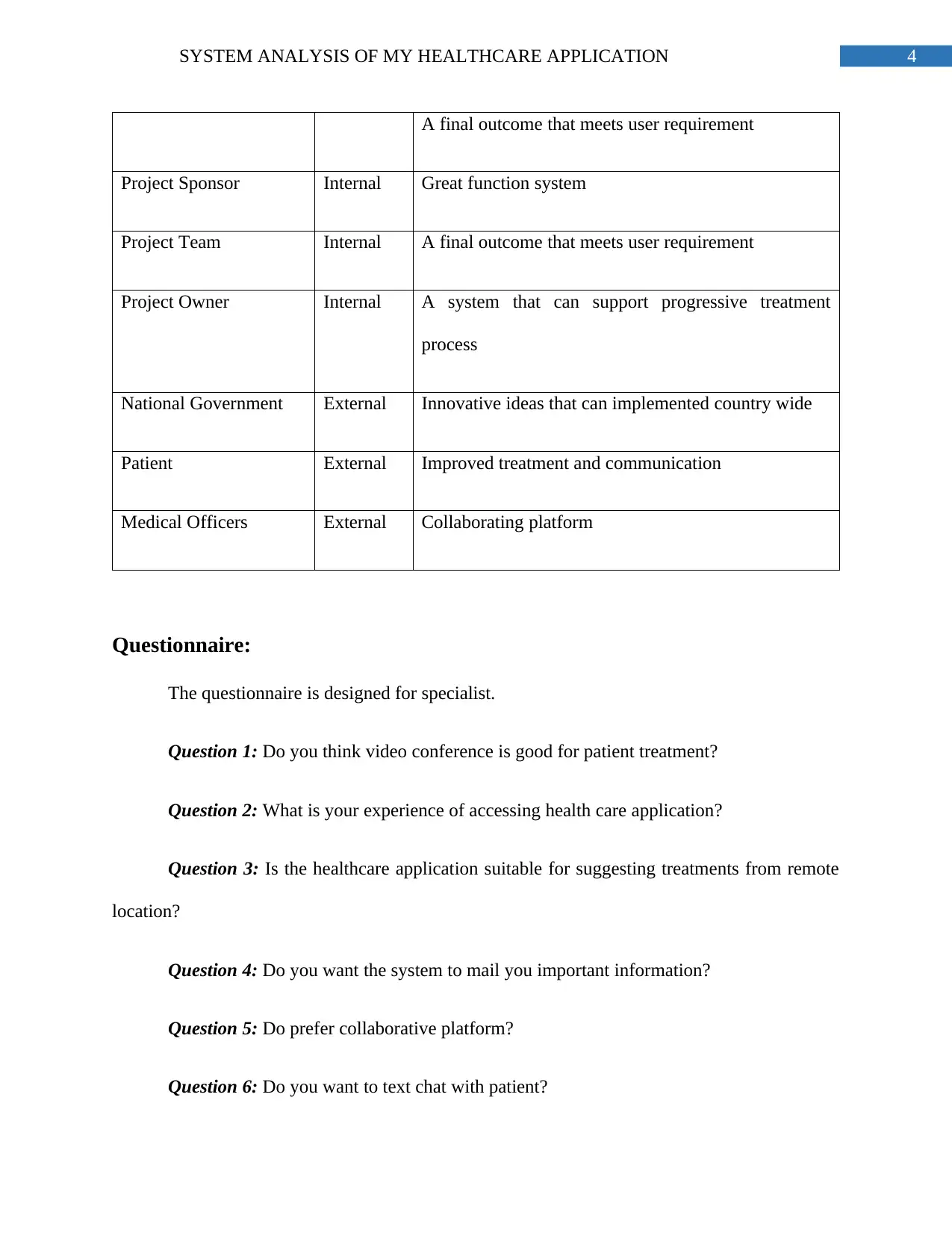
4SYSTEM ANALYSIS OF MY HEALTHCARE APPLICATION
A final outcome that meets user requirement
Project Sponsor Internal Great function system
Project Team Internal A final outcome that meets user requirement
Project Owner Internal A system that can support progressive treatment
process
National Government External Innovative ideas that can implemented country wide
Patient External Improved treatment and communication
Medical Officers External Collaborating platform
Questionnaire:
The questionnaire is designed for specialist.
Question 1: Do you think video conference is good for patient treatment?
Question 2: What is your experience of accessing health care application?
Question 3: Is the healthcare application suitable for suggesting treatments from remote
location?
Question 4: Do you want the system to mail you important information?
Question 5: Do prefer collaborative platform?
Question 6: Do you want to text chat with patient?
A final outcome that meets user requirement
Project Sponsor Internal Great function system
Project Team Internal A final outcome that meets user requirement
Project Owner Internal A system that can support progressive treatment
process
National Government External Innovative ideas that can implemented country wide
Patient External Improved treatment and communication
Medical Officers External Collaborating platform
Questionnaire:
The questionnaire is designed for specialist.
Question 1: Do you think video conference is good for patient treatment?
Question 2: What is your experience of accessing health care application?
Question 3: Is the healthcare application suitable for suggesting treatments from remote
location?
Question 4: Do you want the system to mail you important information?
Question 5: Do prefer collaborative platform?
Question 6: Do you want to text chat with patient?
Paraphrase This Document
Need a fresh take? Get an instant paraphrase of this document with our AI Paraphraser
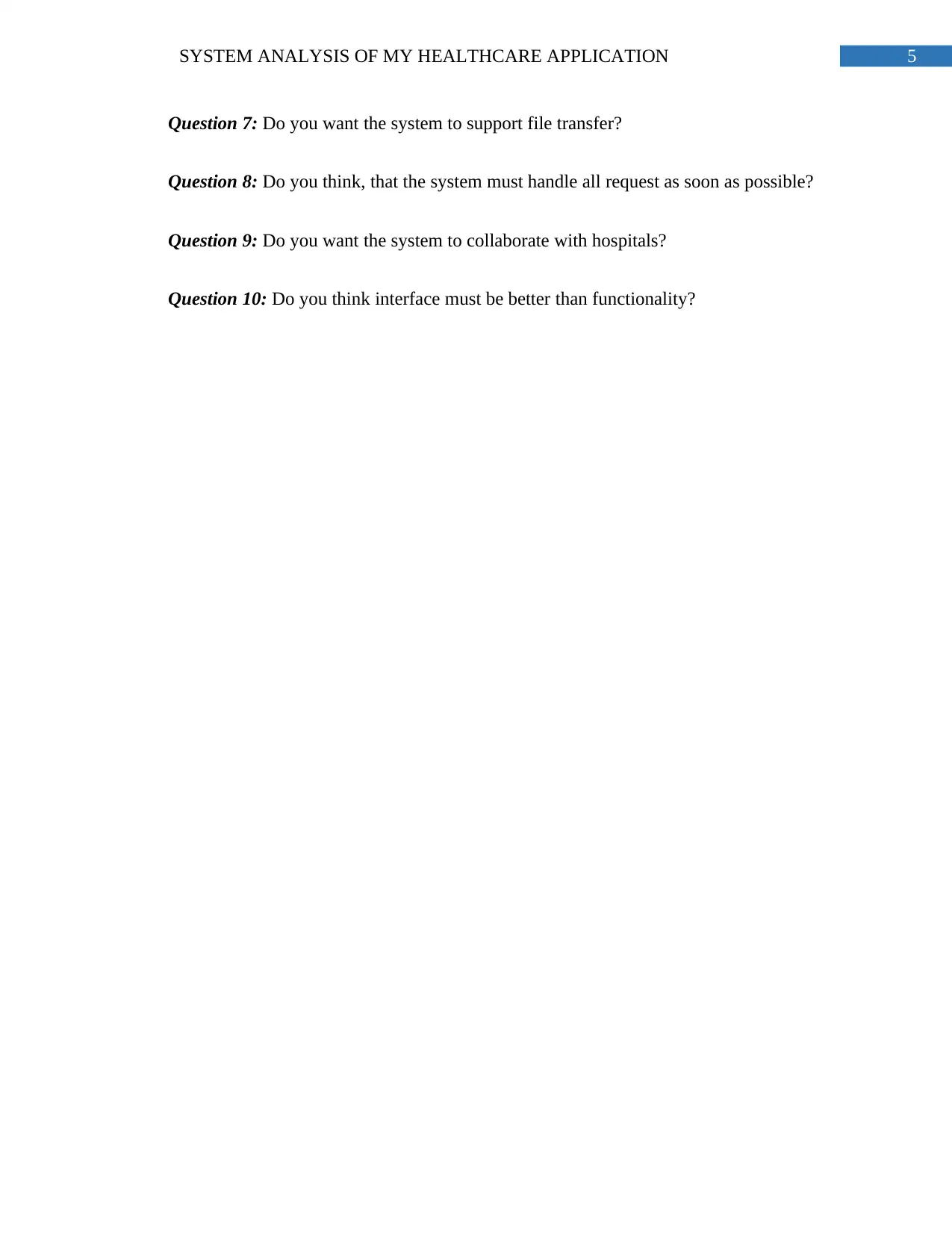
5SYSTEM ANALYSIS OF MY HEALTHCARE APPLICATION
Question 7: Do you want the system to support file transfer?
Question 8: Do you think, that the system must handle all request as soon as possible?
Question 9: Do you want the system to collaborate with hospitals?
Question 10: Do you think interface must be better than functionality?
Question 7: Do you want the system to support file transfer?
Question 8: Do you think, that the system must handle all request as soon as possible?
Question 9: Do you want the system to collaborate with hospitals?
Question 10: Do you think interface must be better than functionality?
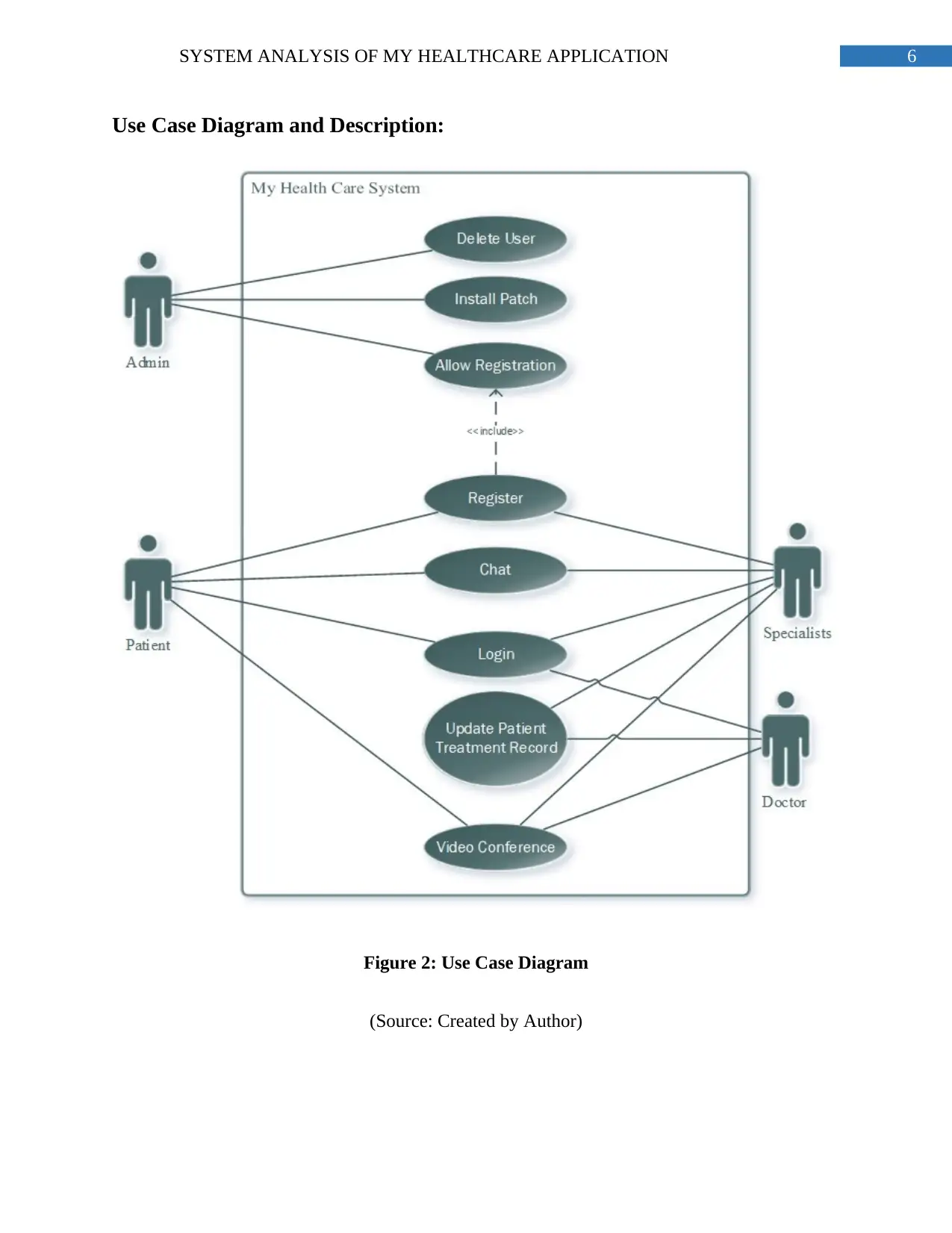
6SYSTEM ANALYSIS OF MY HEALTHCARE APPLICATION
Use Case Diagram and Description:
Figure 2: Use Case Diagram
(Source: Created by Author)
Use Case Diagram and Description:
Figure 2: Use Case Diagram
(Source: Created by Author)
⊘ This is a preview!⊘
Do you want full access?
Subscribe today to unlock all pages.

Trusted by 1+ million students worldwide
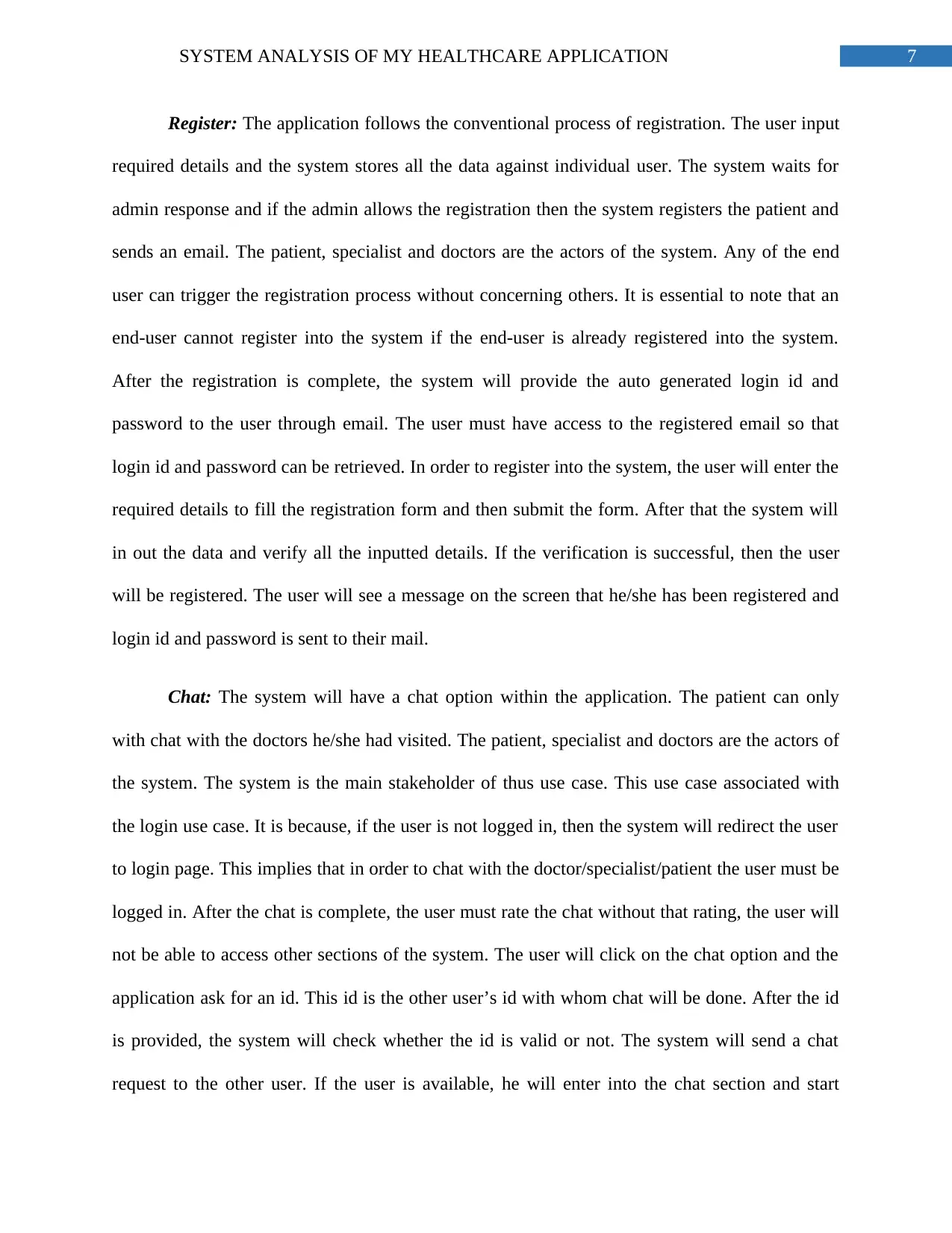
7SYSTEM ANALYSIS OF MY HEALTHCARE APPLICATION
Register: The application follows the conventional process of registration. The user input
required details and the system stores all the data against individual user. The system waits for
admin response and if the admin allows the registration then the system registers the patient and
sends an email. The patient, specialist and doctors are the actors of the system. Any of the end
user can trigger the registration process without concerning others. It is essential to note that an
end-user cannot register into the system if the end-user is already registered into the system.
After the registration is complete, the system will provide the auto generated login id and
password to the user through email. The user must have access to the registered email so that
login id and password can be retrieved. In order to register into the system, the user will enter the
required details to fill the registration form and then submit the form. After that the system will
in out the data and verify all the inputted details. If the verification is successful, then the user
will be registered. The user will see a message on the screen that he/she has been registered and
login id and password is sent to their mail.
Chat: The system will have a chat option within the application. The patient can only
with chat with the doctors he/she had visited. The patient, specialist and doctors are the actors of
the system. The system is the main stakeholder of thus use case. This use case associated with
the login use case. It is because, if the user is not logged in, then the system will redirect the user
to login page. This implies that in order to chat with the doctor/specialist/patient the user must be
logged in. After the chat is complete, the user must rate the chat without that rating, the user will
not be able to access other sections of the system. The user will click on the chat option and the
application ask for an id. This id is the other user’s id with whom chat will be done. After the id
is provided, the system will check whether the id is valid or not. The system will send a chat
request to the other user. If the user is available, he will enter into the chat section and start
Register: The application follows the conventional process of registration. The user input
required details and the system stores all the data against individual user. The system waits for
admin response and if the admin allows the registration then the system registers the patient and
sends an email. The patient, specialist and doctors are the actors of the system. Any of the end
user can trigger the registration process without concerning others. It is essential to note that an
end-user cannot register into the system if the end-user is already registered into the system.
After the registration is complete, the system will provide the auto generated login id and
password to the user through email. The user must have access to the registered email so that
login id and password can be retrieved. In order to register into the system, the user will enter the
required details to fill the registration form and then submit the form. After that the system will
in out the data and verify all the inputted details. If the verification is successful, then the user
will be registered. The user will see a message on the screen that he/she has been registered and
login id and password is sent to their mail.
Chat: The system will have a chat option within the application. The patient can only
with chat with the doctors he/she had visited. The patient, specialist and doctors are the actors of
the system. The system is the main stakeholder of thus use case. This use case associated with
the login use case. It is because, if the user is not logged in, then the system will redirect the user
to login page. This implies that in order to chat with the doctor/specialist/patient the user must be
logged in. After the chat is complete, the user must rate the chat without that rating, the user will
not be able to access other sections of the system. The user will click on the chat option and the
application ask for an id. This id is the other user’s id with whom chat will be done. After the id
is provided, the system will check whether the id is valid or not. The system will send a chat
request to the other user. If the user is available, he will enter into the chat section and start
Paraphrase This Document
Need a fresh take? Get an instant paraphrase of this document with our AI Paraphraser
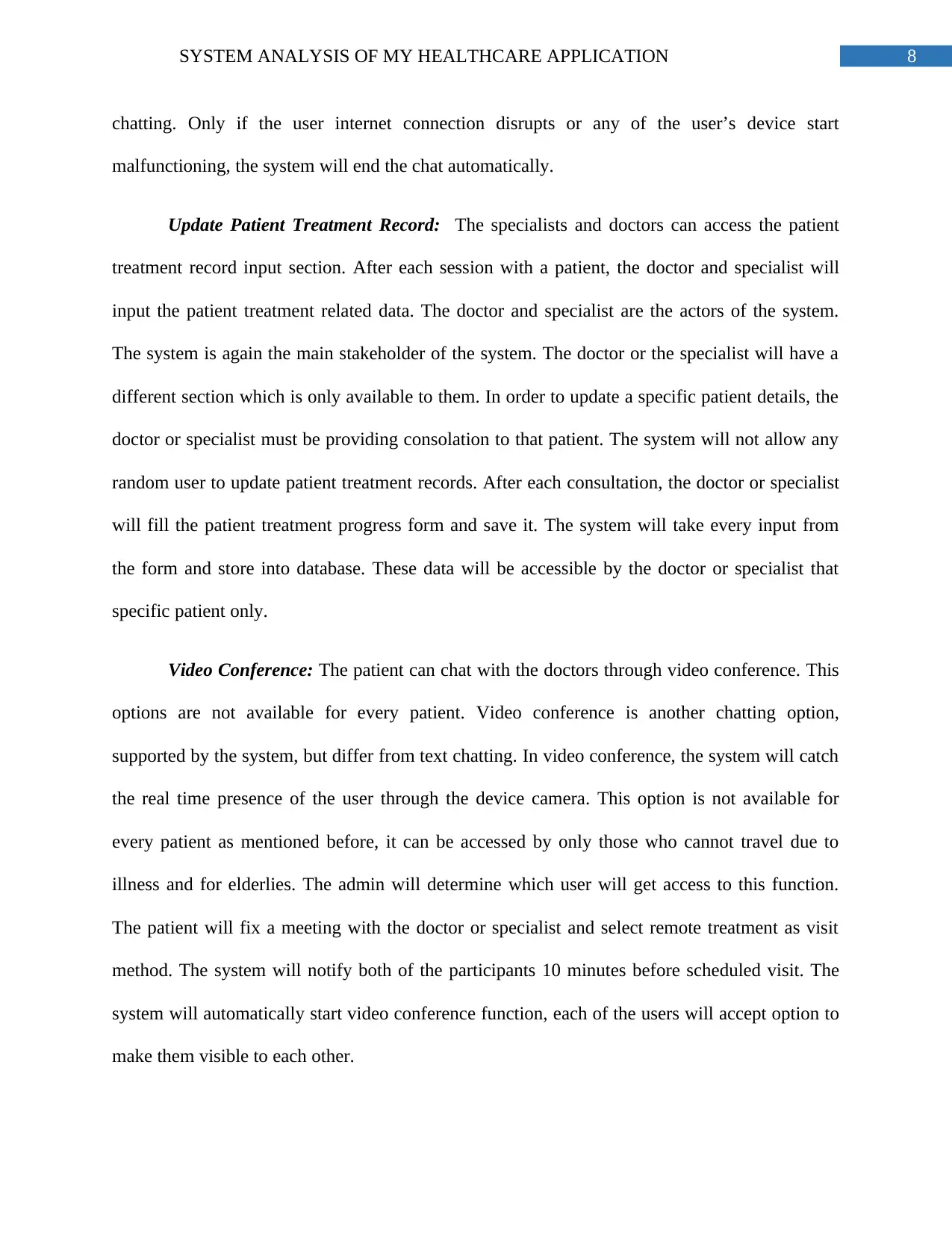
8SYSTEM ANALYSIS OF MY HEALTHCARE APPLICATION
chatting. Only if the user internet connection disrupts or any of the user’s device start
malfunctioning, the system will end the chat automatically.
Update Patient Treatment Record: The specialists and doctors can access the patient
treatment record input section. After each session with a patient, the doctor and specialist will
input the patient treatment related data. The doctor and specialist are the actors of the system.
The system is again the main stakeholder of the system. The doctor or the specialist will have a
different section which is only available to them. In order to update a specific patient details, the
doctor or specialist must be providing consolation to that patient. The system will not allow any
random user to update patient treatment records. After each consultation, the doctor or specialist
will fill the patient treatment progress form and save it. The system will take every input from
the form and store into database. These data will be accessible by the doctor or specialist that
specific patient only.
Video Conference: The patient can chat with the doctors through video conference. This
options are not available for every patient. Video conference is another chatting option,
supported by the system, but differ from text chatting. In video conference, the system will catch
the real time presence of the user through the device camera. This option is not available for
every patient as mentioned before, it can be accessed by only those who cannot travel due to
illness and for elderlies. The admin will determine which user will get access to this function.
The patient will fix a meeting with the doctor or specialist and select remote treatment as visit
method. The system will notify both of the participants 10 minutes before scheduled visit. The
system will automatically start video conference function, each of the users will accept option to
make them visible to each other.
chatting. Only if the user internet connection disrupts or any of the user’s device start
malfunctioning, the system will end the chat automatically.
Update Patient Treatment Record: The specialists and doctors can access the patient
treatment record input section. After each session with a patient, the doctor and specialist will
input the patient treatment related data. The doctor and specialist are the actors of the system.
The system is again the main stakeholder of the system. The doctor or the specialist will have a
different section which is only available to them. In order to update a specific patient details, the
doctor or specialist must be providing consolation to that patient. The system will not allow any
random user to update patient treatment records. After each consultation, the doctor or specialist
will fill the patient treatment progress form and save it. The system will take every input from
the form and store into database. These data will be accessible by the doctor or specialist that
specific patient only.
Video Conference: The patient can chat with the doctors through video conference. This
options are not available for every patient. Video conference is another chatting option,
supported by the system, but differ from text chatting. In video conference, the system will catch
the real time presence of the user through the device camera. This option is not available for
every patient as mentioned before, it can be accessed by only those who cannot travel due to
illness and for elderlies. The admin will determine which user will get access to this function.
The patient will fix a meeting with the doctor or specialist and select remote treatment as visit
method. The system will notify both of the participants 10 minutes before scheduled visit. The
system will automatically start video conference function, each of the users will accept option to
make them visible to each other.
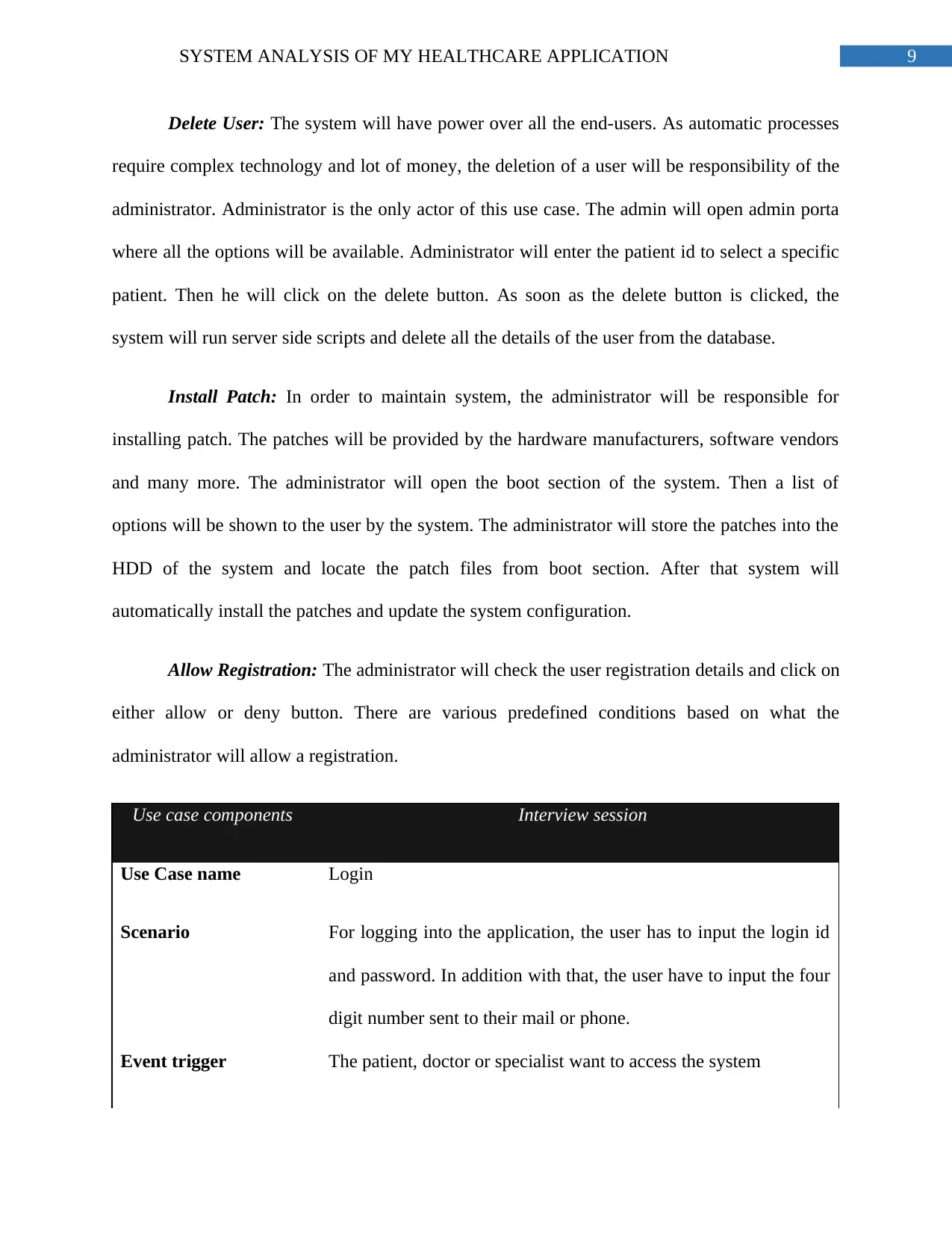
9SYSTEM ANALYSIS OF MY HEALTHCARE APPLICATION
Delete User: The system will have power over all the end-users. As automatic processes
require complex technology and lot of money, the deletion of a user will be responsibility of the
administrator. Administrator is the only actor of this use case. The admin will open admin porta
where all the options will be available. Administrator will enter the patient id to select a specific
patient. Then he will click on the delete button. As soon as the delete button is clicked, the
system will run server side scripts and delete all the details of the user from the database.
Install Patch: In order to maintain system, the administrator will be responsible for
installing patch. The patches will be provided by the hardware manufacturers, software vendors
and many more. The administrator will open the boot section of the system. Then a list of
options will be shown to the user by the system. The administrator will store the patches into the
HDD of the system and locate the patch files from boot section. After that system will
automatically install the patches and update the system configuration.
Allow Registration: The administrator will check the user registration details and click on
either allow or deny button. There are various predefined conditions based on what the
administrator will allow a registration.
Use case components Interview session
Use Case name Login
Scenario For logging into the application, the user has to input the login id
and password. In addition with that, the user have to input the four
digit number sent to their mail or phone.
Event trigger The patient, doctor or specialist want to access the system
Delete User: The system will have power over all the end-users. As automatic processes
require complex technology and lot of money, the deletion of a user will be responsibility of the
administrator. Administrator is the only actor of this use case. The admin will open admin porta
where all the options will be available. Administrator will enter the patient id to select a specific
patient. Then he will click on the delete button. As soon as the delete button is clicked, the
system will run server side scripts and delete all the details of the user from the database.
Install Patch: In order to maintain system, the administrator will be responsible for
installing patch. The patches will be provided by the hardware manufacturers, software vendors
and many more. The administrator will open the boot section of the system. Then a list of
options will be shown to the user by the system. The administrator will store the patches into the
HDD of the system and locate the patch files from boot section. After that system will
automatically install the patches and update the system configuration.
Allow Registration: The administrator will check the user registration details and click on
either allow or deny button. There are various predefined conditions based on what the
administrator will allow a registration.
Use case components Interview session
Use Case name Login
Scenario For logging into the application, the user has to input the login id
and password. In addition with that, the user have to input the four
digit number sent to their mail or phone.
Event trigger The patient, doctor or specialist want to access the system
⊘ This is a preview!⊘
Do you want full access?
Subscribe today to unlock all pages.

Trusted by 1+ million students worldwide
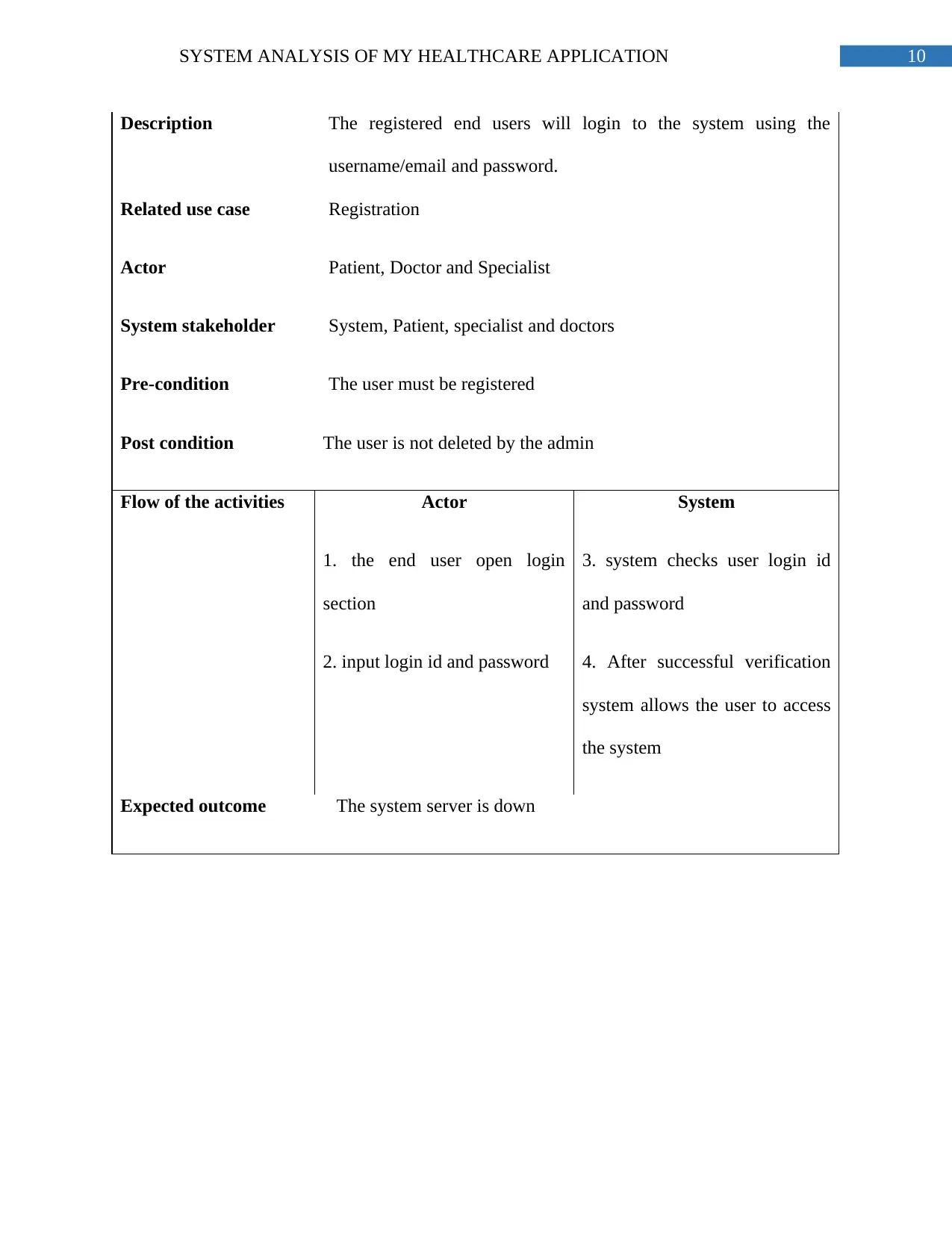
10SYSTEM ANALYSIS OF MY HEALTHCARE APPLICATION
Description The registered end users will login to the system using the
username/email and password.
Related use case Registration
Actor Patient, Doctor and Specialist
System stakeholder System, Patient, specialist and doctors
Pre-condition The user must be registered
Post condition The user is not deleted by the admin
Flow of the activities Actor System
1. the end user open login
section
2. input login id and password
3. system checks user login id
and password
4. After successful verification
system allows the user to access
the system
Expected outcome The system server is down
Description The registered end users will login to the system using the
username/email and password.
Related use case Registration
Actor Patient, Doctor and Specialist
System stakeholder System, Patient, specialist and doctors
Pre-condition The user must be registered
Post condition The user is not deleted by the admin
Flow of the activities Actor System
1. the end user open login
section
2. input login id and password
3. system checks user login id
and password
4. After successful verification
system allows the user to access
the system
Expected outcome The system server is down
Paraphrase This Document
Need a fresh take? Get an instant paraphrase of this document with our AI Paraphraser
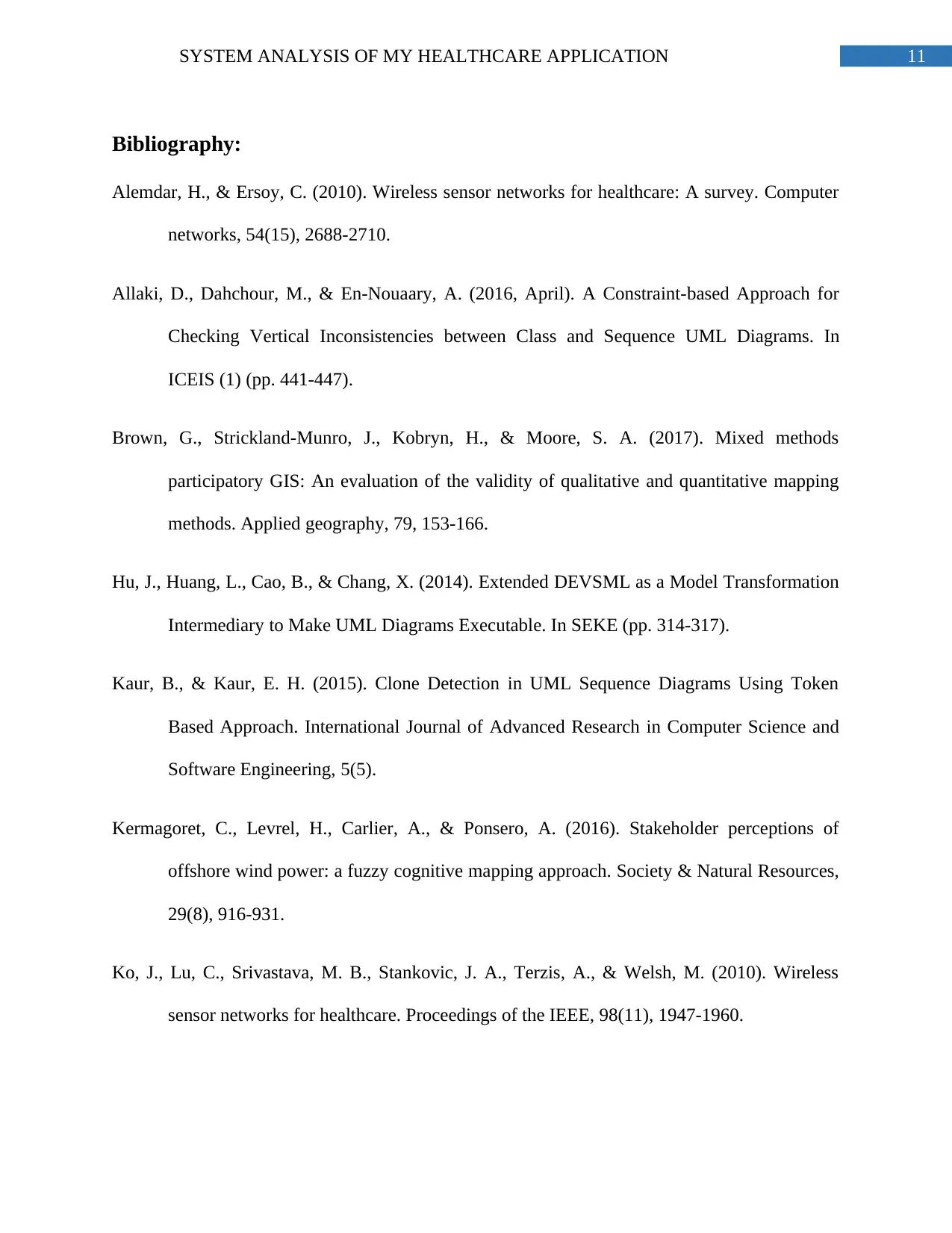
11SYSTEM ANALYSIS OF MY HEALTHCARE APPLICATION
Bibliography:
Alemdar, H., & Ersoy, C. (2010). Wireless sensor networks for healthcare: A survey. Computer
networks, 54(15), 2688-2710.
Allaki, D., Dahchour, M., & En-Nouaary, A. (2016, April). A Constraint-based Approach for
Checking Vertical Inconsistencies between Class and Sequence UML Diagrams. In
ICEIS (1) (pp. 441-447).
Brown, G., Strickland-Munro, J., Kobryn, H., & Moore, S. A. (2017). Mixed methods
participatory GIS: An evaluation of the validity of qualitative and quantitative mapping
methods. Applied geography, 79, 153-166.
Hu, J., Huang, L., Cao, B., & Chang, X. (2014). Extended DEVSML as a Model Transformation
Intermediary to Make UML Diagrams Executable. In SEKE (pp. 314-317).
Kaur, B., & Kaur, E. H. (2015). Clone Detection in UML Sequence Diagrams Using Token
Based Approach. International Journal of Advanced Research in Computer Science and
Software Engineering, 5(5).
Kermagoret, C., Levrel, H., Carlier, A., & Ponsero, A. (2016). Stakeholder perceptions of
offshore wind power: a fuzzy cognitive mapping approach. Society & Natural Resources,
29(8), 916-931.
Ko, J., Lu, C., Srivastava, M. B., Stankovic, J. A., Terzis, A., & Welsh, M. (2010). Wireless
sensor networks for healthcare. Proceedings of the IEEE, 98(11), 1947-1960.
Bibliography:
Alemdar, H., & Ersoy, C. (2010). Wireless sensor networks for healthcare: A survey. Computer
networks, 54(15), 2688-2710.
Allaki, D., Dahchour, M., & En-Nouaary, A. (2016, April). A Constraint-based Approach for
Checking Vertical Inconsistencies between Class and Sequence UML Diagrams. In
ICEIS (1) (pp. 441-447).
Brown, G., Strickland-Munro, J., Kobryn, H., & Moore, S. A. (2017). Mixed methods
participatory GIS: An evaluation of the validity of qualitative and quantitative mapping
methods. Applied geography, 79, 153-166.
Hu, J., Huang, L., Cao, B., & Chang, X. (2014). Extended DEVSML as a Model Transformation
Intermediary to Make UML Diagrams Executable. In SEKE (pp. 314-317).
Kaur, B., & Kaur, E. H. (2015). Clone Detection in UML Sequence Diagrams Using Token
Based Approach. International Journal of Advanced Research in Computer Science and
Software Engineering, 5(5).
Kermagoret, C., Levrel, H., Carlier, A., & Ponsero, A. (2016). Stakeholder perceptions of
offshore wind power: a fuzzy cognitive mapping approach. Society & Natural Resources,
29(8), 916-931.
Ko, J., Lu, C., Srivastava, M. B., Stankovic, J. A., Terzis, A., & Welsh, M. (2010). Wireless
sensor networks for healthcare. Proceedings of the IEEE, 98(11), 1947-1960.
1 out of 11
Related Documents
Your All-in-One AI-Powered Toolkit for Academic Success.
+13062052269
info@desklib.com
Available 24*7 on WhatsApp / Email
![[object Object]](/_next/static/media/star-bottom.7253800d.svg)
Unlock your academic potential
Copyright © 2020–2025 A2Z Services. All Rights Reserved. Developed and managed by ZUCOL.

![System Analysis of My Healthcare Application - [Course Name]](/_next/image/?url=https%3A%2F%2Fdesklib.com%2Fmedia%2Fimages%2Fpn%2Fad0bcc8326b94c3e9a3c863964f34a85.jpg&w=256&q=75)



